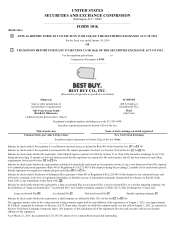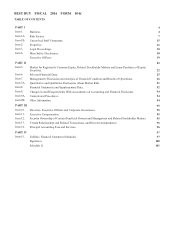Best Buy 2016 Annual Report Download - page 17
Download and view the complete annual report
Please find page 17 of the 2016 Best Buy annual report below. You can navigate through the pages in the report by either clicking on the pages listed below, or by using the keyword search tool below to find specific information within the annual report.9
cease allowing us to offer their contracts, focus their marketing efforts on alternative channels or make unfavorable changes to
our commissions or other terms. Each of these potential factors could have a materially adverse impact on our revenue and
profitability.
We have internal standards that we require all of our vendors to meet. Our ability to find qualified vendors who meet our
standards and supply products in a timely and efficient manner can be a challenge, especially with respect to goods sourced
from outside the U.S. Political or financial instability, merchandise quality issues, product safety concerns, trade restrictions,
work stoppages, port delays, tariffs, foreign currency exchange rates, transportation capacity and costs, inflation, civil unrest,
natural disasters, outbreaks of pandemics and other factors relating to foreign trade are beyond our control. These and other
issues affecting our vendors could materially adversely affect our financial results.
Our focus on services as a strategic imperative exposes us to certain risks that could have a material adverse impact on
our revenue and profitability as well as our reputation.
Our customer promises include provision of a full range of services to complement our product offerings, including
consultation, design, delivery, installation, set-up, protection plans, repair, technical support and educational classes. These
services can differentiate us from many of our competitors and provide an opportunity to deliver superior customer service
while generating incremental revenue and profit. However, designing, marketing and executing these services successfully and
consistently is subject to incremental risks. These risks include, for example:
• increased labor expense to fulfill our customer promises, which may be higher than the related revenue;
• unpredictable warranty failure rates and related expenses;
• employees in transit using company vehicles to visit customer locations and employees being present in customer
homes; these factors may increase our scope of liability related to our employees' actions;
• employees having access to customer devices, including the information held on those devices, which may increase
our responsibility for the security of those devices and the data they hold; and
• the engagement of third party contractors to assist with some aspects of construction and installation and the potential
responsibility for the actions they take and for compliance with building codes and related regulations.
In addition, as customers increasingly migrate to websites and mobile applications to initiate transactions, it is inherently more
difficult to demonstrate and explain the features and benefits of our service offerings, which can lead to a lower revenue mix of
these services. If, for these or other reasons, we fail to design and market services effectively to our customers or fail to meet
our customers’ expectations in the execution of these services, our reputation, revenue and profitability could be adversely
affected.
Macroeconomic pressures in the U.S. and key international markets could adversely affect consumer spending and our
financial results.
To varying degrees, our products and services are sensitive to changes in macroeconomic conditions that impact consumer
spending. As a result, consumers may be affected in many different ways, including, for example:
• whether or not they make a purchase;
• their choice of brand, model or price-point;
• how frequently they upgrade their devices; and
• their appetite for complementary services (for example, protection plans).
Consumer confidence, employment levels, oil prices, interest rates, tax rates, availability of consumer financing, housing
market conditions, foreign currency exchange rate fluctuations, costs for items such as fuel and food and other macroeconomic
trends can adversely affect consumers' demand for the products and services that we offer. Our future results could be
significantly adversely impacted by these factors.
Interruptions to our supply chain and other factors affecting our distribution may adversely affect our business.
Our supply chain is a critical part of our operations, particularly in light of recent industry trends and initiatives such as ship-
from-store and the emphasis on fast and free delivery when purchasing online. We also depend on third parties for certain
aspects of our supply chain network. In managing our supply chain we are exposed to the following risks, for example, which
may not be fully controllable by us:
• interruptions to our delivery capabilities;
























